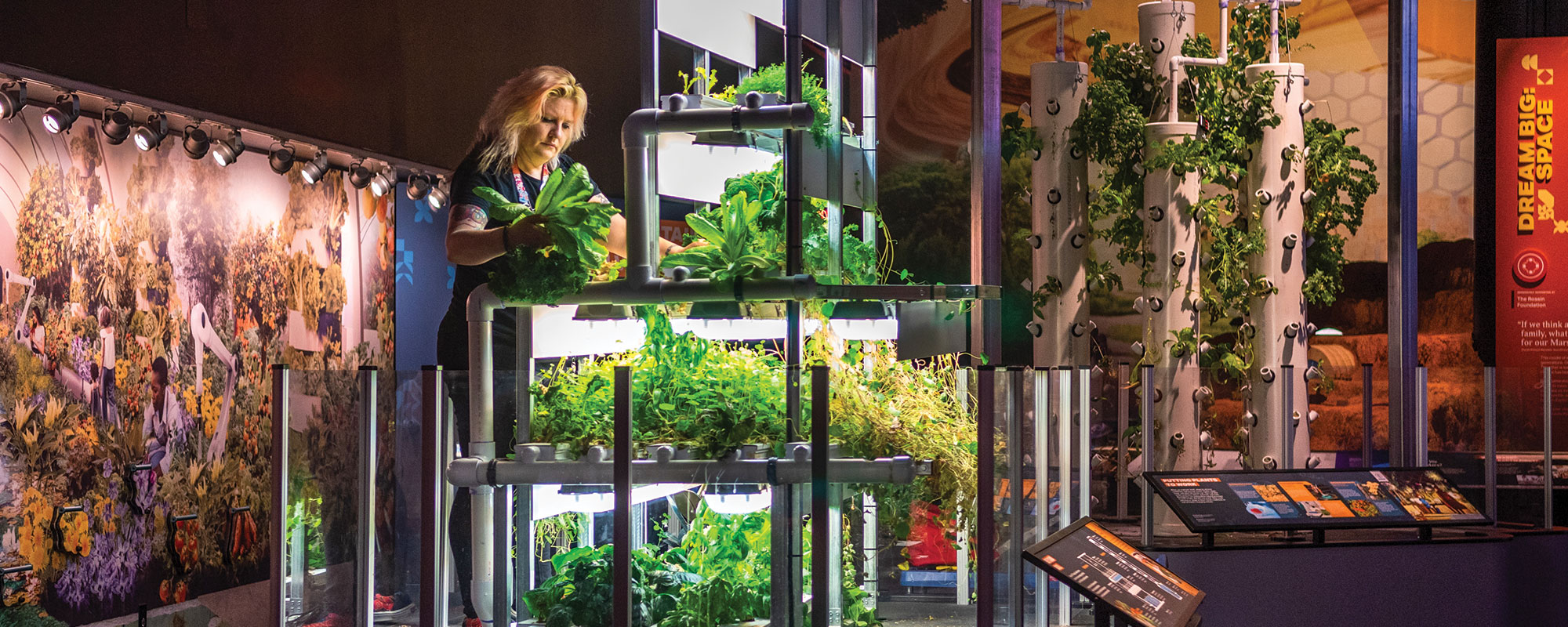Past the arid oranges and ruddy browns of the Science Center’s exhibition on the red planet, lush green vegetation grows in towers that stretch toward the 25-foot ceiling.
“This is actually a working farm,” says Marcus Harshaw, senior director of museum experiences at Carnegie Science Center, who headed the creation of Mars: The Next Giant Leap, a permanent exhibition that opened last November. “When you come back and see all this green, it’s like, wait a minute—what’s going on?”
These hydroponic systems follow the mission of the 7,400-square-foot exhibition to imagine what it would take to survive and thrive on Mars in a climate-controlled environment. Food would be of utmost importance, along with resource management.
“Everything we grow here scientifically suggests we would grow them on Mars in a similar fashion,” Harshaw says. “We’re not going to transport a lot of materials to Mars. We’ll have to grow a lot of it ourselves.”
Plants range from the curly tendrils of sugar pod peas to leafy kale, from strawberries to sweet peppers and radishes. There are herbs to keep Martian meals tasty, like parsley, thyme, and oregano. In a unique farm-to-table design, all the harvested produce feeds the creatures downstairs in the Science Center’s living collection. Romaine lettuce is a favorite of the turtles, while the insects, including the supersize grasshoppers, will munch everything down to its roots. The farm produces about a pound per week, but the team hopes to build that to 8 pounds per week to fill the animals’ needs.
Much thought goes into choosing plants beyond the palates of the Science Center’s creatures, though. Multiuse plants help illustrate how earthlings on Mars might make best use of nutrition and resources within space constraints.
Carla Littleton, animal and habitats manager at the Science Center, whose department took on the farming duties, points to the nasturtium with its lily-pad-like leaves as an example.
“The flowers are edible,” Littleton says. “They’re very high in vitamin A and vitamin C. The leaves are edible. They are very similar to spinach. And the seeds are high in protein.”
Littleton was brought into the Mars project development team early on. With a background in agricultural science and education, they were a serendipitous in-house find to work on the farming aspect of the exhibition.
“We were trying to look at not only what would feed our animals, but what kind of plants would you need on Mars?” Littleton says. “You wouldn’t be able to take all of your medicine with you. Your best bet is to have the plants there that would produce that medicine. Hence, medicinal herbs grow among the plant collection.”
“Everything we grow here scientifically suggests we would grow them on Mars in a similar fashion.”
– Marcus Harshaw, Senior Director of Museum Experiences at Carnegie Science Center
Mental health is another consideration, with research looking into how living alongside and tending live plants can be helpful on Earth, let alone on a desolate place like Mars. Littleton hopes to add a small willow tree whose bark can be used to create aspirin. There’s even a rubber plant that could provide adhesives for repairs on the Martian habitat. Who wants to wait for that next shipment when it’s coming from 300 million miles away?
Littleton has embraced their duties with an infectious enthusiasm. They hope to surprise some visitors by including more unexpected plants like pineapple and Brussels sprouts because of their unusual growth. (A pineapple grows in the center of a big plant that looks like an agave, while Brussels sprouts grow on a big stick.) Pumpkins are also on the list.
The Mars team knows they’re hitting the mark when visitors ask the all-important question: “Can I do this at home?” Pittsburgh is a city with a lot of “food deserts”—communities without ready access to healthy and affordable food—and Littleton is eager to demonstrate how residents of those communities could address this problem within their own neighborhoods.
“We’ve taken this and made demonstrations to teach people how to build tabletop ones for themselves out of things they can buy locally,” Littleton says, “because this is important. This is something we can do on another planet, but how can we take this and address current issues, social issues, and community issues?”
The Martian farm is a small example of how space program research brings about innovations that improve life on Earth, such as GPS, solar cells, LASIK surgery, and insulin pumps. Here, we see how even imagining those possibilities can lead to change. While hydroponic systems are not new, they are likely to become more widely used as drought and flood due to climate change compromise traditional farming practices, as well as home gardening.
“As we move forward from here on our own planet, it’s all about resource use,” Harshaw says. “When you have less water to use, if you have less space, how can you grow things?”
The Science Center’s smallest hydroponic system cycles 43 gallons of water for two weeks, for example, while a home gardener might use 43 gallons of water per day to replenish their plants.
“I’m hoping that people see this,” he says, “and what they take away is thinking about how they can better use resources on Earth today because of how they are going to have to use resources on Mars tomorrow.”
Receive more stories in your email
Sign upTags:
Science & Nature
